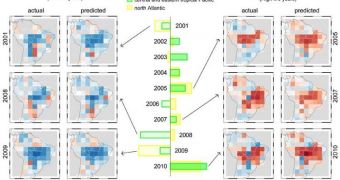A collaboration of researchers in the United States just published a new paper in the top journal Science, describing how changes in sea temperatures can be used as a clear indicator for forecasting wildfires that will hit South America.
The team, led by experts from the University of California in Irvine (UCI) Department of Earth System Science, says that the drive to conduct the new work came from the rather different, yet eerily-similar childhood experiences of two investigators, Jim Randerson and Yang Chen.
One of them grew up in San Diego, while the other spent his childhood in southeastern China, during a time when the countless factories that now exist in the Asian nation were just being built. As such, Chen witnessed how the quality of air and water changed first-hand.
What they managed to show in the new Science paper is that very small variations in the surface temperatures of oceans can be indicative of how severe upcoming wildfires will be. The data can also be used to estimate the devastation these natural phenomena will have on the Amazon rainforest.
One of the most interesting aspects of this correlation is that it has a great potential of causing a vicious circle. When forests burn, they release stored carbon dioxide, which goes on to pollute the air and fuel global warming, therefore contributing to increasing ocean temperatures, and causing more wildfires.
“I’ve always viewed the Amazon as a giant pump that affects the global climate. There are so many processes going on that any perturbation in this ‘pump’ is worthwhile to study,” explains Chen, who is an assistant project scientist at the DESS, and also the lead author of the research.
“This work has very clear implications for conserving tropical forests. Understanding in advance whether you’re going to have an exceptionally bad fire year will become critically important for managing them,” adds Randerson, who is a DESS Earth system science professor.
The duo says that rainforests are extremely important in controlling Earth's climate, primarily because they are able to store so much carbon dioxide. This is the primary greenhouse gas driving global warming and climate change today.
Chen and Randerson also used NASA satellite weather data and maps to investigate how ocean temperature variations can lead to powerful Atlantic hurricanes, changed rainfall patterns along the rim of the Pacific Ocean, and more intense droughts in the Amazon.
“These changes are slight, but they trigger big effects in these tropical forest ecosystems,” Chen concludes. Experts from the NASA Goddard Space Flight Center (GSFC), in Greenbelt, Maryland. Columbia University, Duke University and the University of Maryland were also a part of the research.

 14 DAY TRIAL //
14 DAY TRIAL //